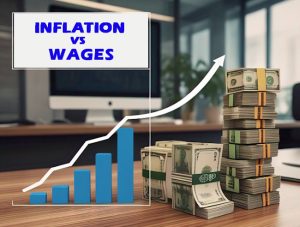Inflation, the rate at which the general level of prices for goods and services rises, erodes purchasing power and poses significant challenges for economies. During periods of high inflation, individuals face increased living costs, prompting many to reassess their employment situations. Further, inflation influences job market turnover rates, as workers seek better opportunities to maintain their financial stability.
We will explore the correlation between rising prices and employee mobility, the psychological factors driving job changes during inflationary periods, and the implications for employers navigating this turbulent landscape. By understanding these dynamics, we can gain insights into the broader economic environment and its effects on workforce behavior.
Rising Living Costs and the Push for Higher Wages
Inflation erodes workers’ purchasing power, leading to increased financial stress as the cost of living rises faster than their wages. In 2023, while wages grew by 4.1%, surpassing the general inflation rate of 3.35%, core inflation (excluding food and energy) was closer to wage growth at 3.9%. This necessitated higher wage increases for workers to maintain their purchasing power.
Workers pursue higher wages in response to these economic pressures, particularly in industries like retail, hospitality, and manufacturing, which are experiencing significant turnover due to inflation-related financial strain. For instance, the food production and transportation sectors have been critically impacted, facing rising costs that stress profit margins and employee retention. Ultimately, inflation drives many to seek better-paying jobs, highlighting the connection between inflation and wage-related job changes.
Employer Challenges in Retaining Talent
Businesses face mounting challenges in retaining employees as rising wage demands strain limited resources. Sectors like education, hospitality, and retail are particularly affected, where budget constraints make it difficult to meet these wage expectations. In response, companies are increasingly adopting alternative retention strategies to mitigate turnover. Offering benefits such as enhanced health insurance, retirement plans, and mental health support can enhance job satisfaction.
Additionally, providing flexible work schedules or remote work options helps cater to employees’ changing needs. For instance, many schools are implementing wellness programs and professional development opportunities to retain teachers, while restaurants may introduce incentive bonuses or improved working conditions to keep staff engaged. By focusing on these initiatives, employers can create a more supportive work environment that balances employee needs with budgetary limitations, ultimately fostering greater retention amidst challenging economic conditions.
The Role of Inflation in Career Transitions
Inflation has become a significant motivator for workers seeking new opportunities or upskilling for higher-paying roles. With nearly half of job switchers in 2022 receiving raises that beat inflation, compared to 42% of loyal employees, many opt to job-hop for financial stability. This trend highlights a shift in workplace dynamics, as younger workers, particularly Gen Z, experienced even greater success, with 60% receiving above-inflation raises.
The Great Resignation has empowered employees to prioritize their financial well-being, prompting a reevaluation of job satisfaction and compensation. As career expert Alison Green notes, employers are increasingly willing to overlook short tenure in candidates, making job-hopping an appealing strategy for those feeling undervalued.
Broader Economic Consequences of Increased Turnover
High turnover rates present significant productivity and operational challenges for businesses, as frequent staff changes disrupt workflows, hinder team cohesion, and dilute institutional knowledge. The financial burden of recruitment and training is substantial, often exceeding a substantial percentage of an employee’s annual salary. Replacing an employee can be costly, with estimates suggesting that the expense can range from 50% to 200% of the individual’s salary, varying by industry.
Sustained turnover can weaken the labor market, as businesses struggle to maintain a stable workforce. This instability can stifle innovation and growth, as companies prioritize onboarding new hires over strategic development. Moreover, when employees frequently cycle through jobs, the collective workforce loses valuable experience, ultimately limiting overall economic productivity and growth potential. This trend underscores the need for employers to invest in retention strategies to foster a more stable and engaged workforce.
Conclusion
Inflation drives higher turnover rates as employees seek financial stability through better-paying opportunities. Many workers, especially younger generations, have successfully job-hopped for raises that outperform inflation, prompting a shift in workplace dynamics. For employers, this trend presents challenges such as decreased productivity and increased recruitment costs, as replacing staff can incur substantial financial burdens.
To navigate inflation-driven turnover, employers should prioritize employee retention through competitive salaries, comprehensive benefits, and opportunities for professional growth. Additionally, fostering a positive workplace culture can enhance job satisfaction and loyalty. For workers, continuous upskilling and networking can create more opportunities for advancement, allowing them to better adapt to the evolving job market. Both parties must recognize the impact of inflation on employment trends and work collaboratively towards sustainable solutions.


Leave a Reply